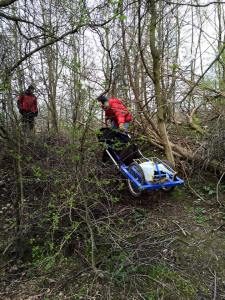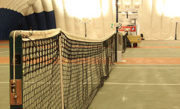A training camp in England specializes in training provincial namesake for rescue operations.

Kicker
Cameron Kilfoy
Newfoundland dogs were initially bred as work dogs for fishermen. The breed’s courageous nature and webbed feet make them ideal for water rescue.
Groups in Europe have recognized what Newfoundlanders have known for many, many decades and are training the breed to save lives there.
South Yorkshire is where the Rother Valley Training Group is located. The training camp has been in existence for over 25 years. Part of the Northern Newfoundland Club in England, strives to promote, protect and develop the breed. At Rother Valley, they train their dogs for water rescue and draught tests.
Draught or carting, is how Newfoundland dogs are taught to maneuver the cart and haul weight. They train for this in the colder weather conditions. In the warmer weather of spring and summer, they begin water training.

Rother Valley coordinator, Vincenti Leather, has a strong love and connection to the breed and has owned Newfoundland dogs for 30 years. He believes Newfoundland dogs are the perfect breed to become rescue dog’s and the idea came from using their natural ability to their best advantage.
“The Newfoundland dog makes a good water rescue dog because it has tremendous power in the water,” said Leather. “From about 1984, a group of like-minded people got together to swim their dogs and have fun with them in the water. I would not say it is a program as such, it is more a way of keeping the dog’s natural abilities alive and showing the Newfoundland dog owners their capabilities.”
Leather has been with this program for quite some time. He states he is not a professional trainer but has a passion for showing the talents of the breed. He says there is a significant benefit in making Newfoundland dogs rescue animals.
“Newfoundland dogs would be a great asset to human lifeguards because they are very strong and would be capable of doing multiple rescues,” he said. “They can assist a lifeguard to retrieve people from the water and even tow an inflatable dinghy back to shore with the occupants in it,” said Leather.
The Newfoundland dogs have an extensive history in Europe after almost becoming extinct here in St. John’s. The government tried to make families pay taxes on their pets which nearly wiped them out, but people from overseas saw the beauty in the dog and started breeding and showing off the breed in England. The first Newfoundland dog was seen in the UK at a show in 1860.
Bonnie Intveld lives here in St. John’s with her husband and three Newfoundland dogs, Jackson Brown, Maggie Mae, and Duchess Nova. She says it was always her dream to own Newfoundland dogs and got her first pup in 2007.
Intveld has heard of carting before but never heard of another program such as the one in Yorkshire. She says it makes sense for the program to be based in Europe because they have a higher demand for the breed.

“The Newfoundland dog is the only dog I know that does the breaststroke, so they’re powerful, said Intveld. “Their tails are supposed to be like propellers, their webbed feet give them more strength and their droopy mouth allows water to pass through easier,” she said. “They’re made for the water. They’re a perfect breed to put out as sea rescue dogs.”
Intveld says Newfoundland dogs have a certain awareness and wit about them, she says.
“It is just the fearlessness about them … the way they carry themselves and their natural ability to protect,” said Intveld.




Be the first to comment